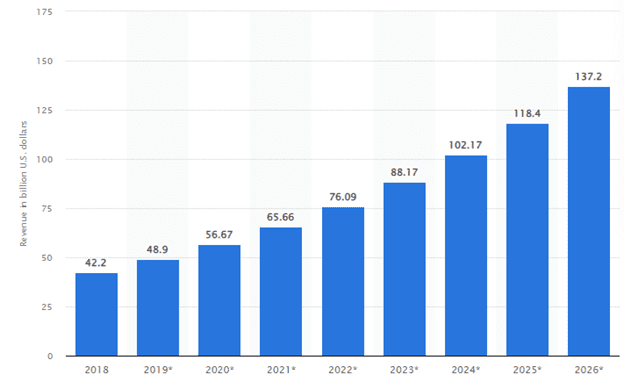When asked about the most effective digital marketing tactic, 20% of marketers claimed that content marketing drives the best results. 4%, on the other hand, suggested that Search Engine Optimization (SEO) is a more viable and cost-effective way to grow businesses. Here is a graph illustrating the results of a survey in this regard.

Source: Statista
SEO and content marketing both manage to showcase average performance. However, when you combine SEO and Content Marketing effectively, your marketing campaign can reach a larger audience and has a significantly higher probability of success.
Think of content marketing as books and magazines, where SEO represents a way of cataloging them for everyone to find.
Using our analogy, SEO and content marketing would only attract readers to an extent on their own. However, readers would likely have a hard time looking for a specific book. By executing both together, you can create a library with information sorted into logical categories.
Search engine “spiders” look at both these aspects individually and together. These spiders analyze the HTML/CSS code to find key terms pertaining to a search query and then return their findings to search engines. The algorithms then rank the pages according to the relevance to the query.
SEO makes it easier for content to be recognized, helping search engines compare it to one of the most important updates so far: the E.A.T (Expertise, Authoritativeness, and Trustworthiness).
All this might seem a bit too obvious to many of you, but many marketing teams focus on one or the other in isolation. Even if marketers combine SEO and content marketing, they may not be doing it effectively.
In this article, we will share some critical elements you need to keep in mind when searching for the perfect balance between the two. However, before we get into the tips to combine content marketing, let us take a quick peek at what the concepts truly entail.
Content Marketing – A Quick Overview
Content marketing entails creating, arranging, and distributing information to your readers. Of course, the information you host on your website must provide value to your target audience, be relevant to their queries, and be consistent. The goal isn’t just to attract; it is to retain and ultimately drive profitable customer interactions.
Expertly written content connects with your audience on a much deeper level and drives meaningful results. Some benefits include:
- Building customer loyalty
- Positioning yourself as a subject matter expert (SME)
- Demonstrating thought leadership
- Offering valuable insights and useful answers to customers
- Building trust and rapport with your audience
When the COVID-19 pandemic began, ~86% marketers suggested they increased their reliance on social media content, while ~66% increased their dependence on video content.
Content marketing can be broken down into three main categories:
- Search engine marketing
- Email marketing
- Social media platforms marketing

Above is a graph showing the revenue potential from content marketing. By 2026, many senior executives estimate that global revenue is expected to reach $137.2 billion because it continues to increase in relevance for digital audiences.
SEO – A Quick Overview
Nearly 64% of marketers actively spend time on Search Engine Optimization. SEO is basically the practice of showing search engines you exist and that your web pages have the information necessary to satisfy customer queries. Content marketing continues to be the most prominent way of doing so, followed by video and social media marketing.
Where content marketing targets customers, SEO targets search engines and their search patterns. There are slight differences in how you target a specific keyword for your digital marketing strategy across the different search engines. However, the bottom line for all engines is the same; answering customer queries precisely and effectively
There are different SEO techniques out there based on how SEO algorithms work, including but not limited to the following;
- Keyword placement
- Enhancing metadata
- Tag placement and use
- Strategic sitemaps
- Backlinking
Why Combine Content Marketing & SEO
Following is a graph showcasing research conducted by Databox about the most critical component of an SEO-friendly website.

Source: Databox
This shows content is a key driver for a website to be considered SEO-friendly.
Even the most engaging article, video, or infographic might not be able to perform if it doesn’t show up on search engines. For that, you need to drive traffic to your content, and the best method to achieve this goal is a combination of SEO and content marketing.
Conversely, exceptional and targeted SEO ventures may fail if the content created cannot connect with your audience. Search engines reward great content but, at the same time, penalize content that fails to convert or has a very high bounce rate.
SEO is also closely linked to website design. As a marketer, you might not be as adept at HTML or CSS as you’d be at keyword research or content creation, which is why there are many helpful, FREE website creators and editors. Choose a website editor that suits your needs perfectly before combining SEO and content marketing.
Now, let us look at some tips and tricks you can employ to ensure you get the best possible results.
Tips to Combine Content Marketing & SEO
1. Research & Write
The best way to ensure that your SEO and content strategy stay aligned is to write in a targeted manner. You need to adopt a much-targeted approach, write what your visitors want to read, and use the keywords they are most searching for.
It is no secret that search volume is one of the most important aspects of choosing a keyword. When selecting a topic to create content on, you can quickly figure out what the best term to target is with the help of Google Analytics.
You should not expect search results immediately. Give it a few months, and you’ll eventually start seeing a marked difference in your website traffic! Just remember not to over-stuff keywords else search engines might penalize you.
2. Quality Over Quantity
It is tempting to churn out words and post an article upon an article with all the relevant keywords stuffed in it. This may work on newer search engines but not on established ones such as Google, Bing, DuckDuckGo, and more.
Search engine bots and quality raters (evaluators) constantly look for websites that churn out content but don’t focus on high-quality content. Search engines prefer quality over quantity.
It’s not just about the number of keywords in your piece of content or the word count or link building that determine how well your content ranks, but the value it offers. By overstuffing links or keywords, you may see a slight improvement in your rank, but it won’t last.
We mentioned how search engines want you to focus on E.A.T (expertise, authoritativeness, and trust). All three factors ultimately depend on how well-researched and in-depth your relevant content is.
When combining content marketing and SEO, focus on content quality first and then move on to SEO optimization. Start increasing your word count only when you are sure that your quality won’t suffer because of it.
3. Engagement & Feedback
Engagement and feedback are two very different concepts. Engagement means that your visitors aren’t just coming to your website and leaving without interacting with elements of your website. The more clients engage, the higher chance of conversion there is.
This is because engagement means an enjoyable user experience, which ultimately builds trust; and is an essential element for conversion.
A podcast published by McKinsey in 2022 showed that customer feedback remains one of the best ways to improve business practices, products, and revenue potential and enhance customer experience.
Questions like what customers would like to see improved, why customers didn’t buy from you, or their concerns can help to identify opportunities to optimize your site and increase conversion.
For SEO, you also need to improve customer experience. Search engines track conversions and the overall time customers spend on your website. The length of time visitors spend on your website tells search engines that customers are finding value in the content and information. This, in turn, increases your site’s page ranking on search engines.
4. Cross-Linking: The Perfect SEO & Content Blend
Internal linking is often overlooked as an essential element of SEO. It is no secret that pages and articles on your website should contain links to other pages on your site as well as external links to content related to your page.
This is known as cross-linking. It plays a vital role in increasing traffic on a website as search engine spiders find your content. As you build content on your site, keep pages organized so users can find them again through your sitemap and breadcrumbs.
5. Find Golden Backlinks
“Good content creates its own backlinks.”
When generating an SEO strategy, you have a large pool of tools and techniques at your disposal, each ready to help you scale and drive traffic your way. One of the most authoritative means among them is effective backlinking.
How beneficial a backlink is to your website depends entirely on the domain authority (DA) of the website linking to you. As a general rule, it is best to only consider websites with a better domain authority than your own.
One website with a very high domain authority that often gets overlooked is Wikipedia. While we don’t recommend linking to Wikipedia, having the encyclopedia link to you can be a game-changer.
The main pillar that keeps Wikipedia authoritative and a reliable source of information its use of footnotes to support its claims, which includes links leading to other websites. Whenever any of its links break or end up dead, Wikipedia gives editors the freedom to find a replacement.
To take advantage of this, simply paste the following in Google (or any other search engine for that matter);
site:wikipedia.org insert keyword “dead link”
You will see a list of websites with dead links in them. Here, our keyword was “USA”.

Source: Google
Click on the page that you find is most relevant to your website. You will find either of the following

OR

Source: Wikipedia
Try opening that URL, and you should see a broken link or an error 404. Copy the URL and check what it was with the help of cache tools such as archive.org. If the page is actually similar to your business, you can replace the broken link with your own
This process is known as cross-linking. It plays an important role in increasing traffic on a website as search engine spiders find your content. As you continue to build content on your site, keep pages organized so users can find them again through your sitemap and breadcrumbs.
Conclusion
Content marketers and SEO specialists possess unique skill sets but combining their areas of expertise can be a powerful asset. The main goal is to create better customer experiences, and DJD Marketing is here to help!
Our team of experts has helped clients deliver value to customers through enhanced SEO practices. We have experience in SEO, and content marketing, as well as a full digital marketing service portfolio to improve your website’s expertise, authority, and trustworthiness.
Get in touch to see how our innovative approach to your digital marketing ventures can help you stand out from the crowd, starting today!

